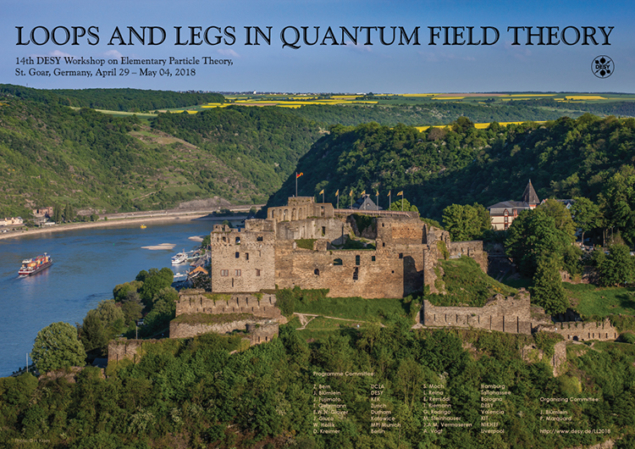
The international conference Loops and Legs in Quantum Field Theory 2018 took place from 29 April to 4 May near Rheinfels Castle in St Goar, Rhine, Germany. The conference brought together more than 100 researchers from 18 countries to discuss the latest results in precision calculations for particle physics at colliders and associated mathematical, computer-algebraic and numerical calculation technologies. It was the 14th conference in the series, with 87 talks delivered.
Organised biennially by the theory group of DESY at Zeuthen, the locations for Loops and Legs are usually remote parts of the German countryside to provide a quiet atmosphere and room for intense scientific discussions. The first conference took place in 1992, just as the HERA collider started up, and the next event, close to the start of LEP2 in 1994, concentrated on precision physics at e+e– colliders. Since 1996, general precision calculations for physics at high-energy colliders form its focus.
This year, the topics covered new results on: the physics of jets; hadronic Higgs-boson and top-quark production; multi-gluon amplitudes; multi-leg two-loop QCD corrections; electroweak corrections at hadron colliders; the Z resonance in e+e– scattering; soft resummation, e+e– → tt̅; precision determinations of parton distribution functions; the heavy quark masses and the fundamental coupling constants; g-2; and NNLO and N3LO QCD corrections for various hard processes.
On the technologies side, analytic multi-summation methods, Mellin–Barnes techniques, the solution of large systems of ordinary differential equations and large-scale computer algebra methods were discussed, as well as unitarity methods, cut-methods in integrating Feynman integrals, and new developments in the field of elliptic integral solutions. These techniques finally allow analytic and numeric calculations of the scattering cross-sections for the key processes measured at the LHC.
All of these results are indispensable to make the LHC, in its high-luminosity phase, a real success and to help hunt down signs of physics beyond the Standard Model (CERN Courier April 2017 p18). The calculations need to match the experimental precision in measuring the couplings and masses, in particular for the top-quark and the Higgs sector, and an even more precise understanding of the strong interactions.
Since the first event, when the most advanced results were single-scale two-loop corrections in QCD, the field has taken a breath-taking leap to inclusive five-loop results – like the β functions of the Standard Model, which control the running of the coupling constant to high precision – to mention only one example. In general, the various subfields of this discipline witness a significant advance every two years or so. Many promising young physicists and mathematicians participate and present results. The field became interdisciplinary very rapidly because of the technologies needed, and now attracts many scientists from computing and mathematics.
The theoretical problems, on the other hand, also trigger new research, for example in algebraic geometry, number theory and combinatorics. This will be the case even more with future projects, like an ILC, and planned machines such as the FCC, which needs even higher precision. The next conference will be held at the beginning of May 2020.








